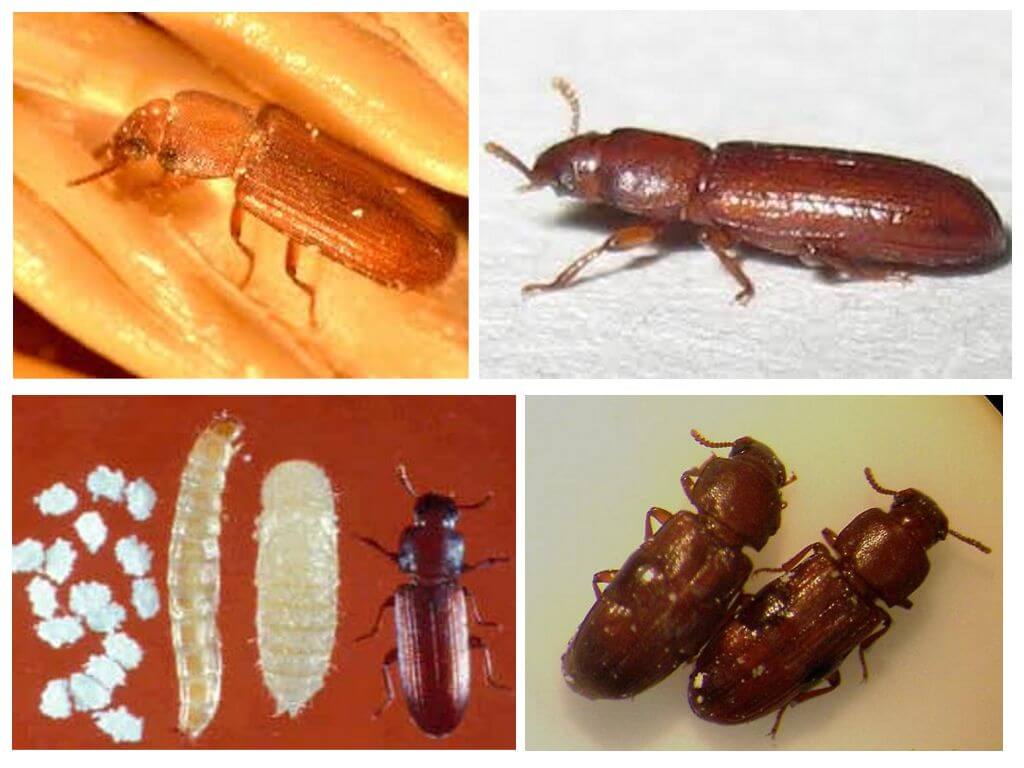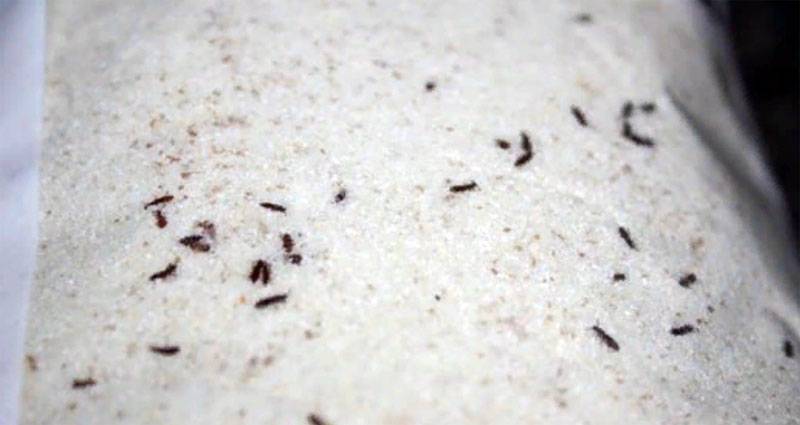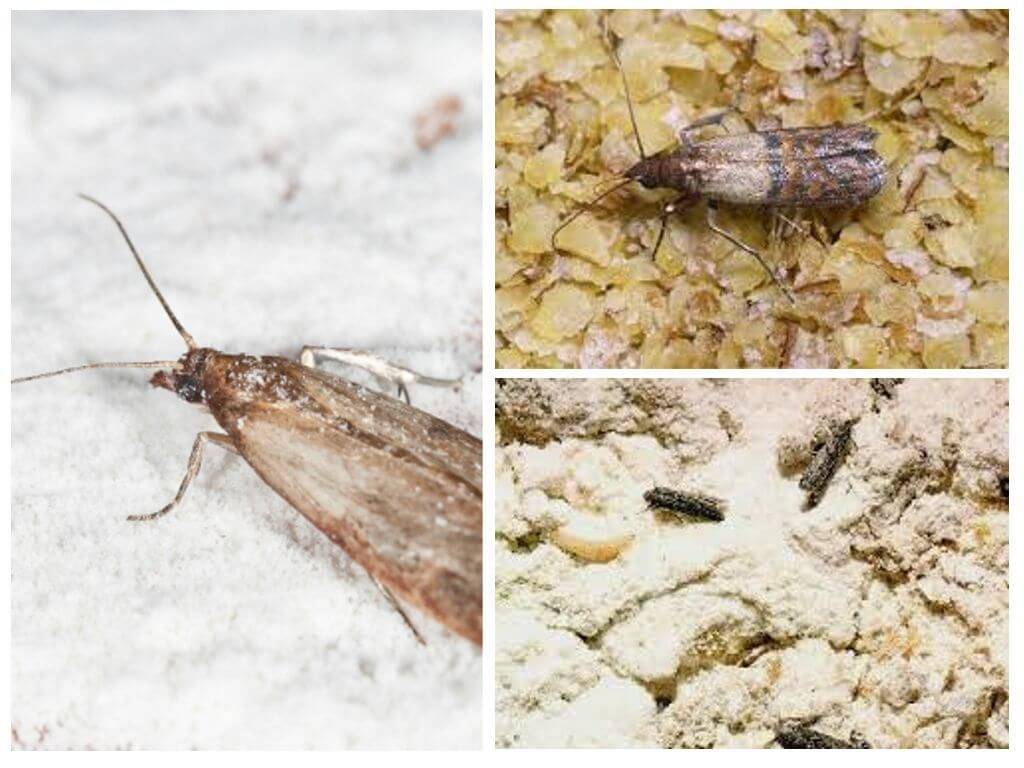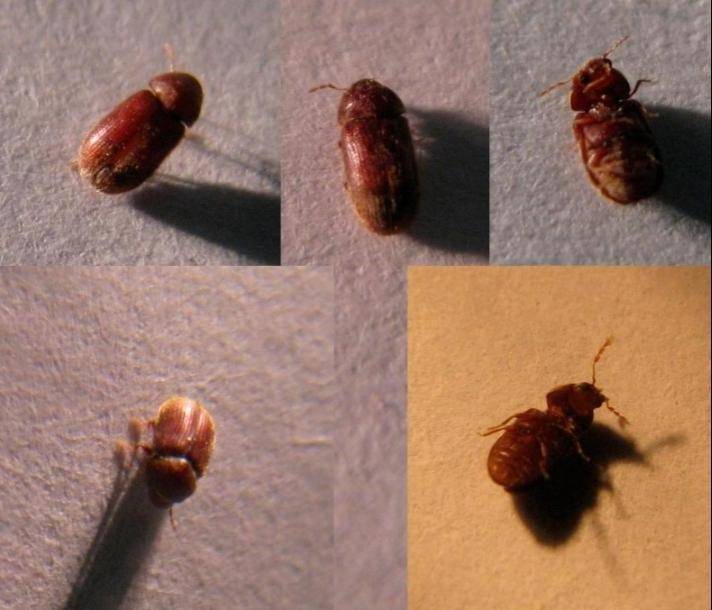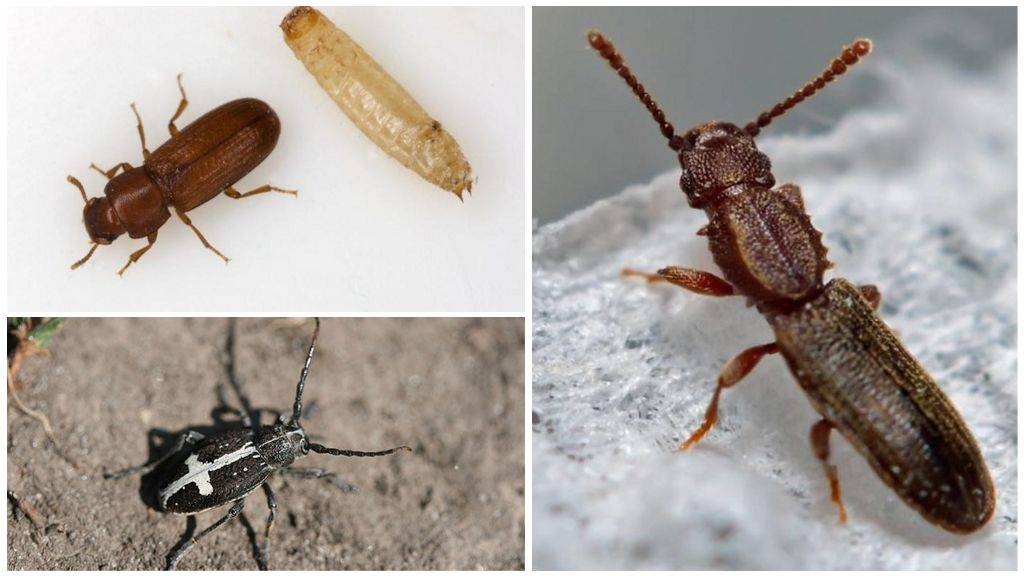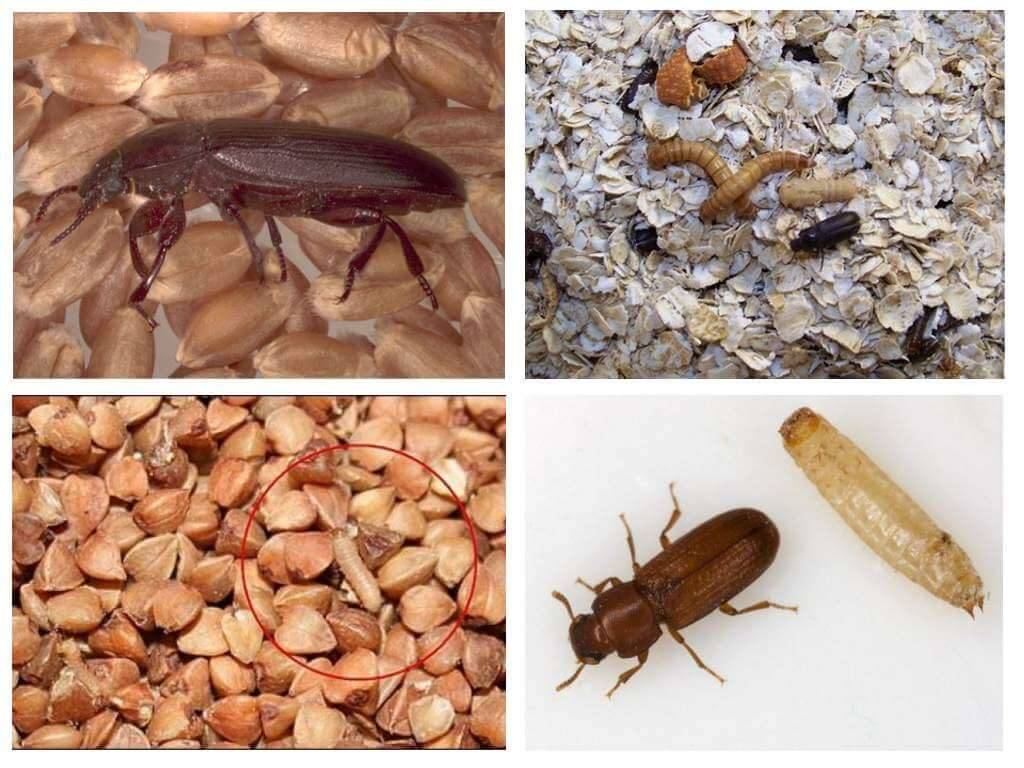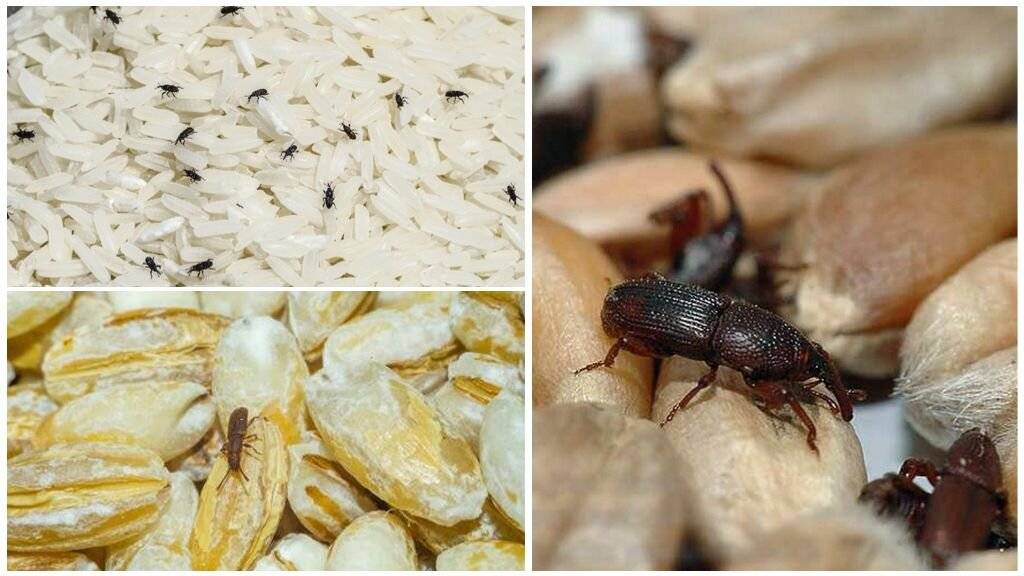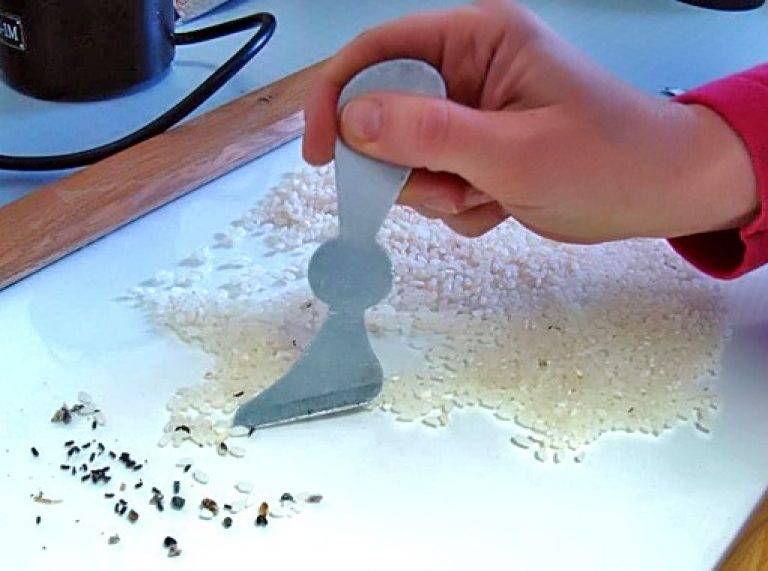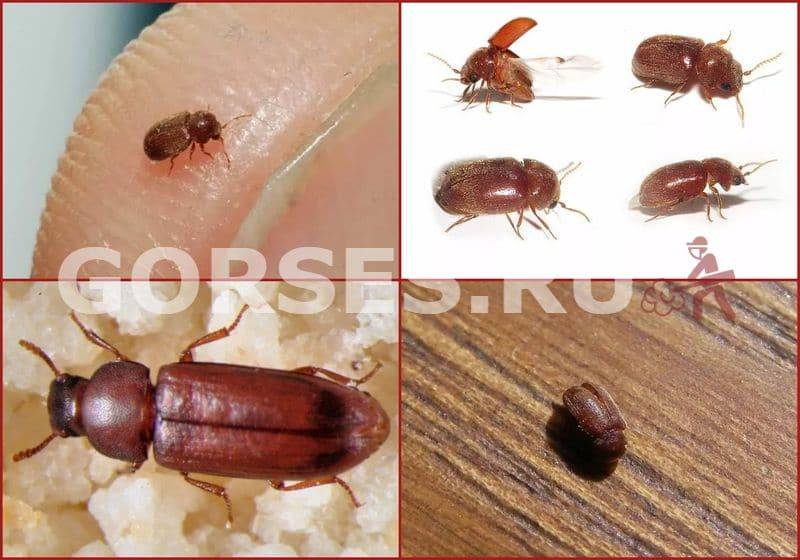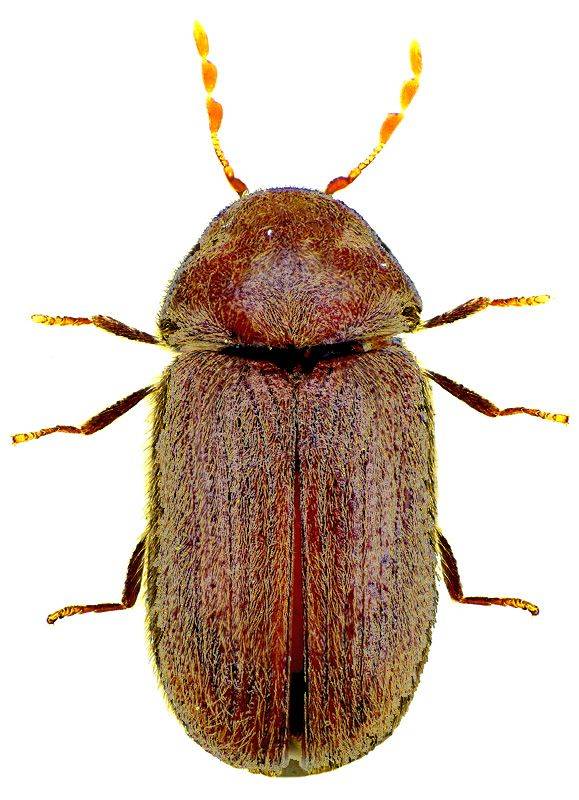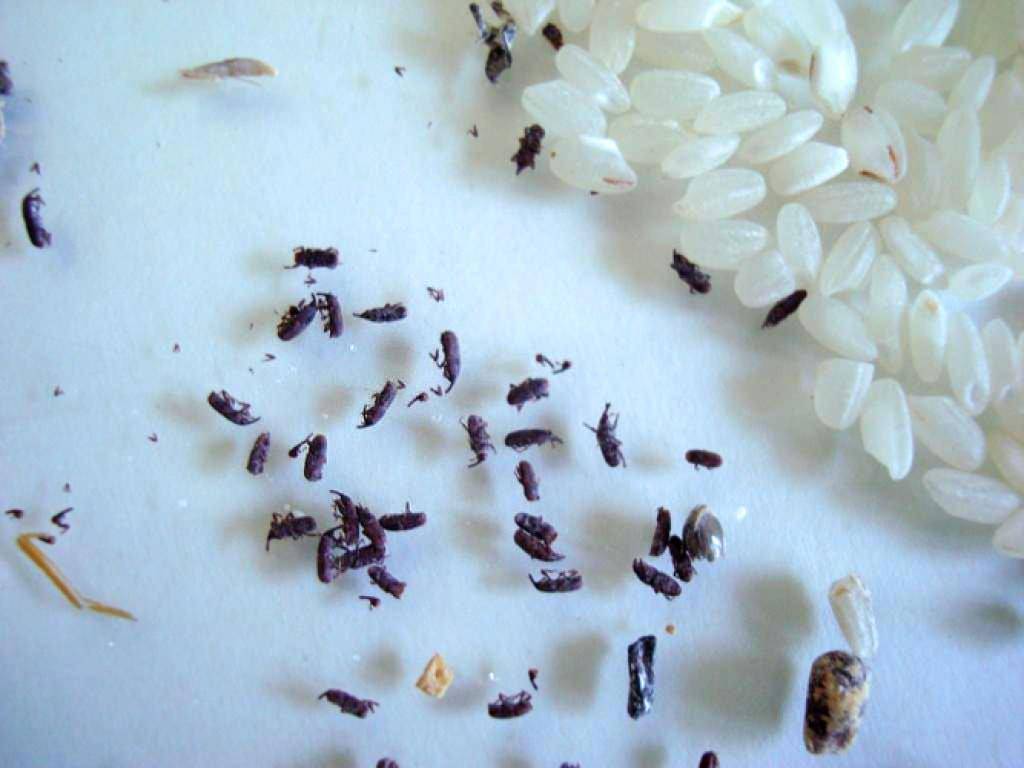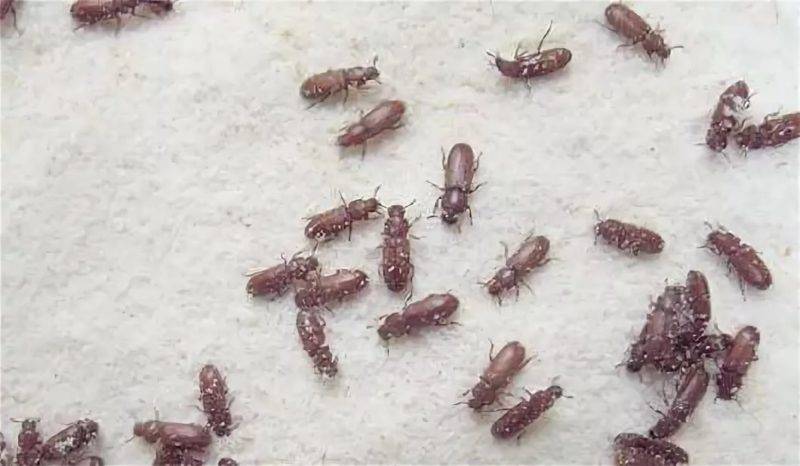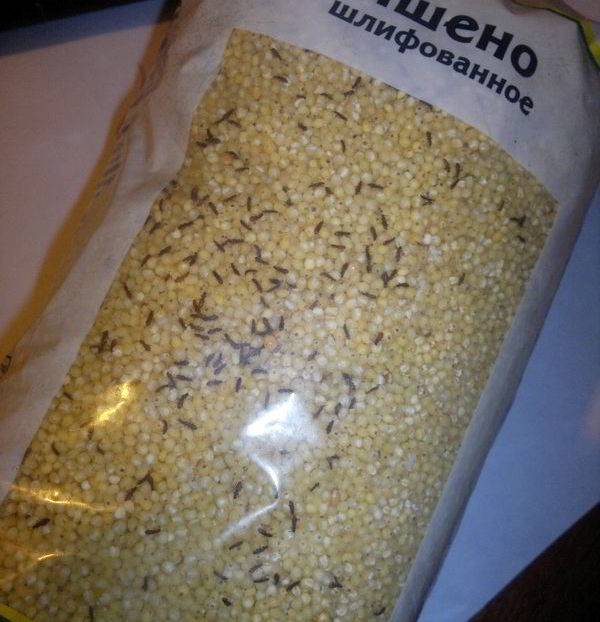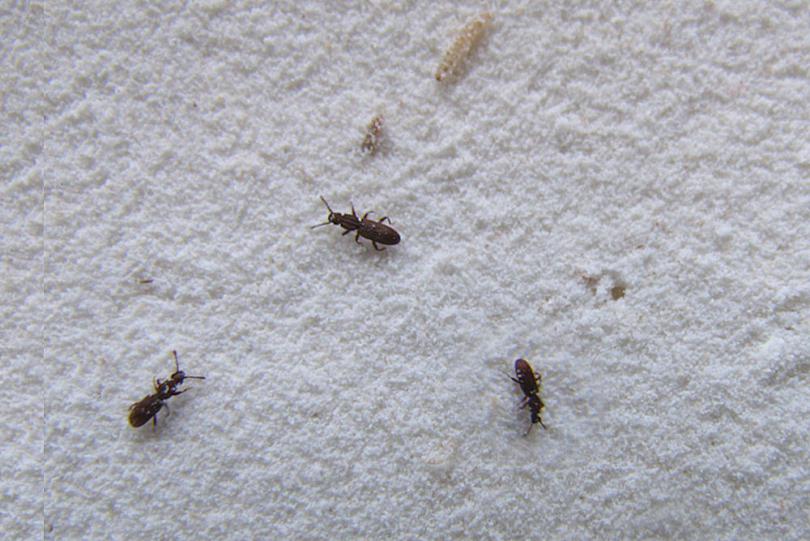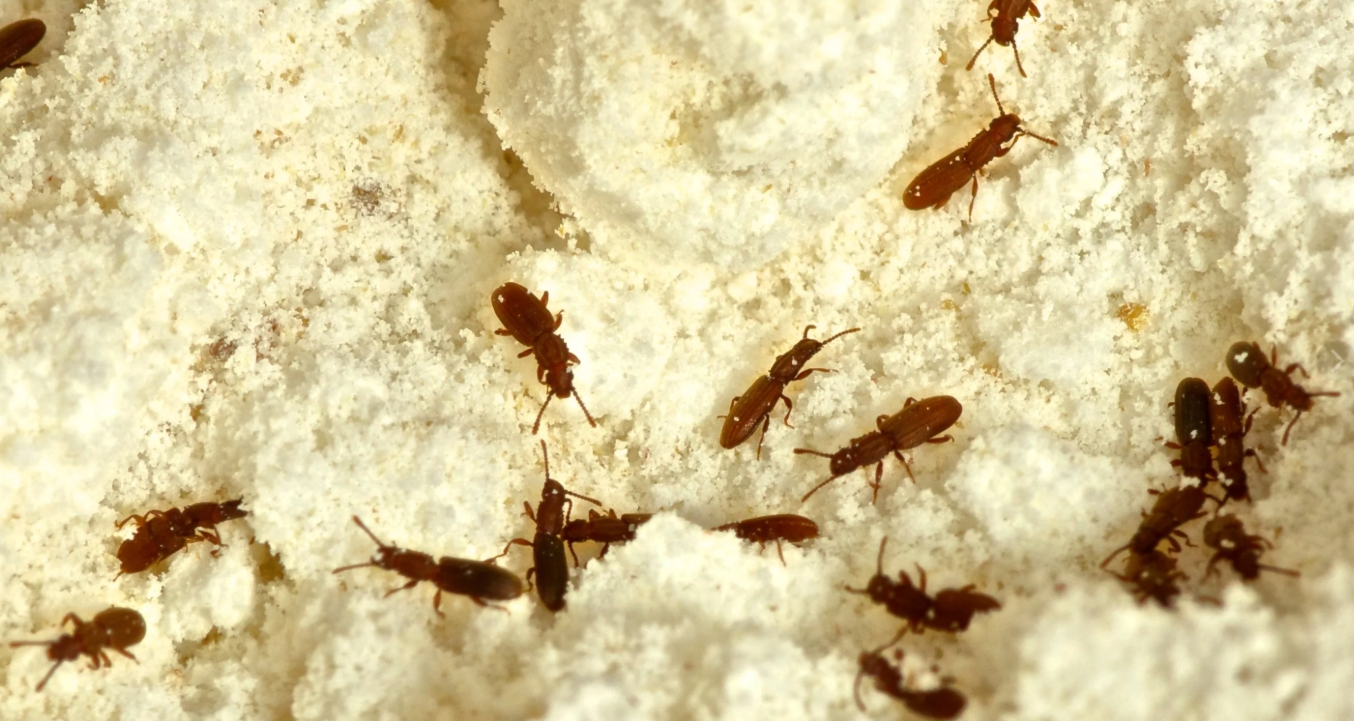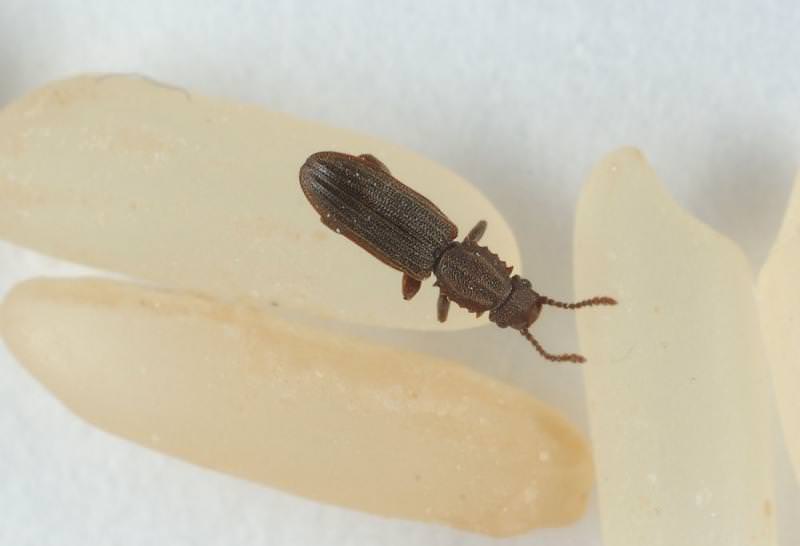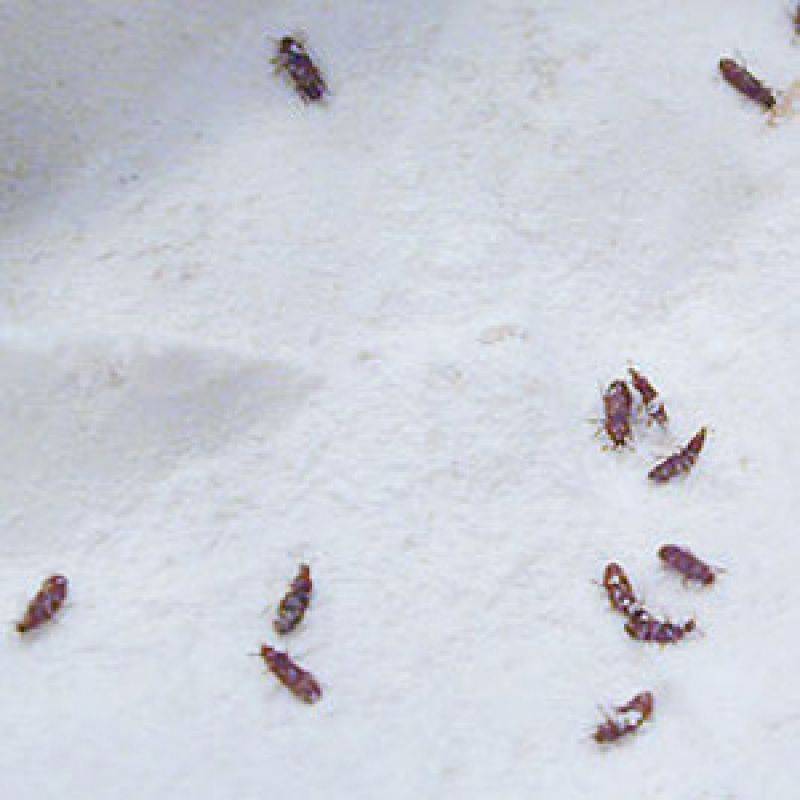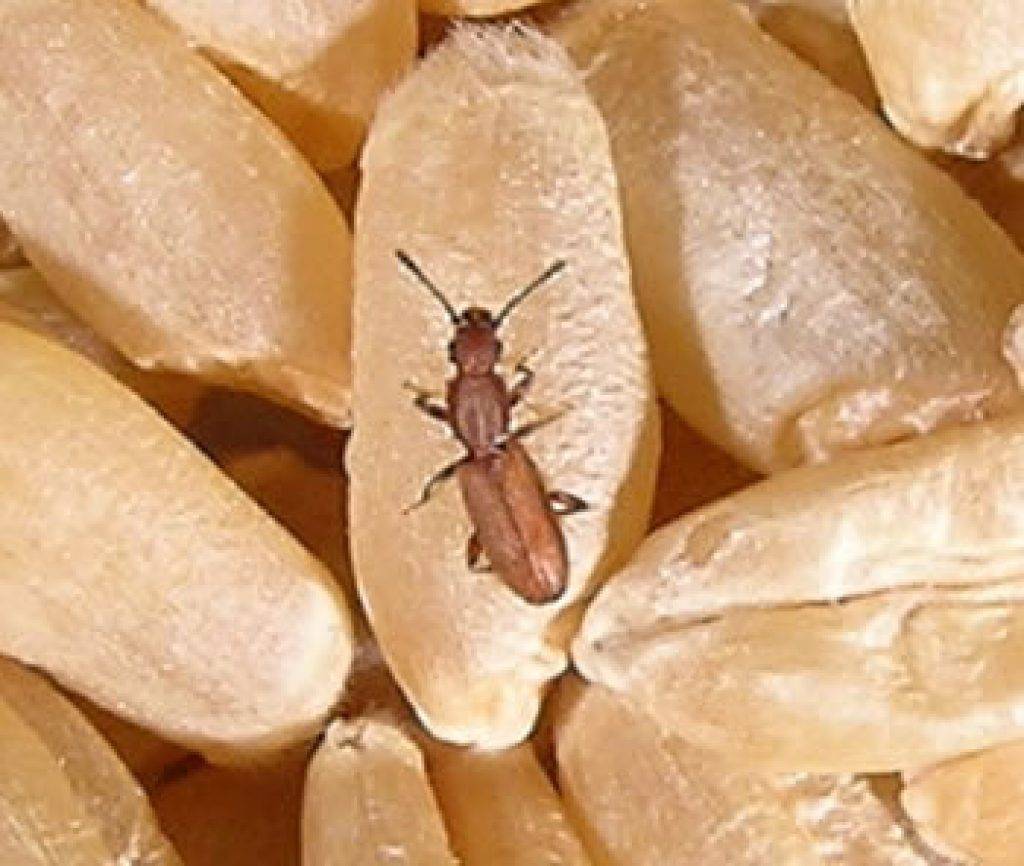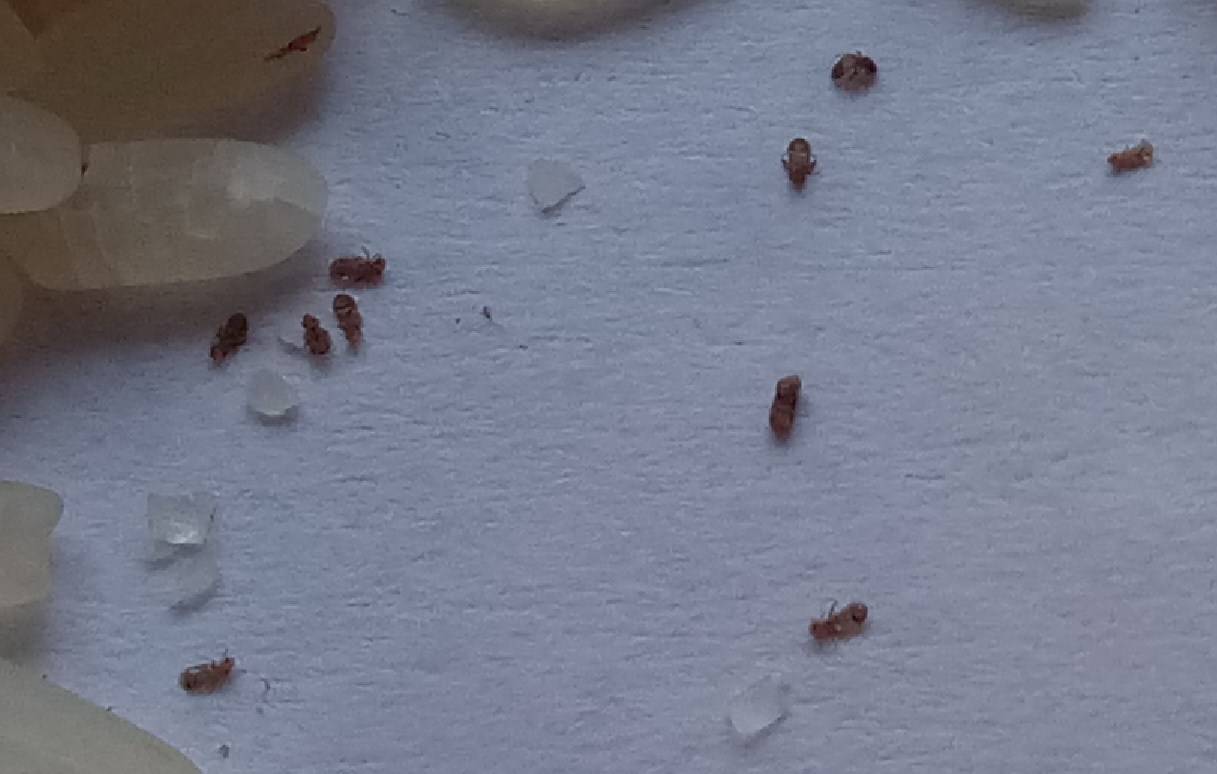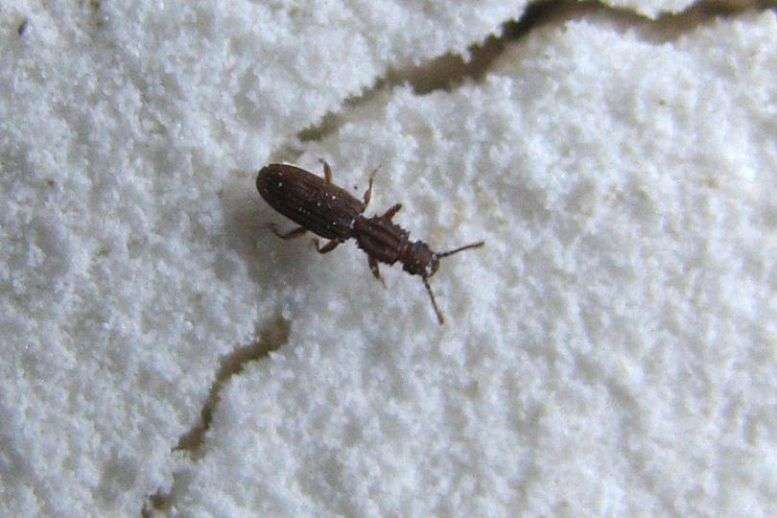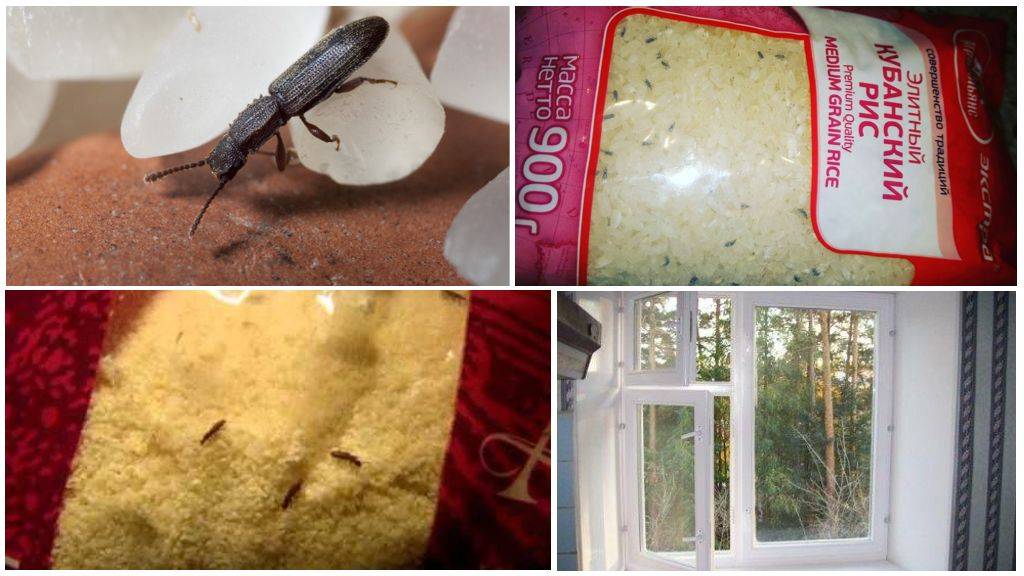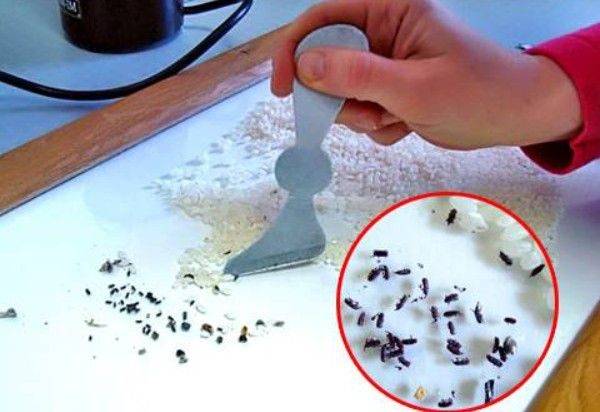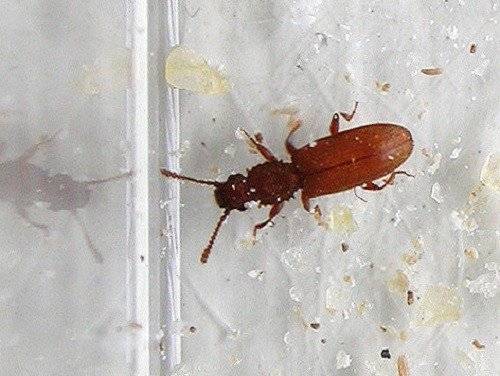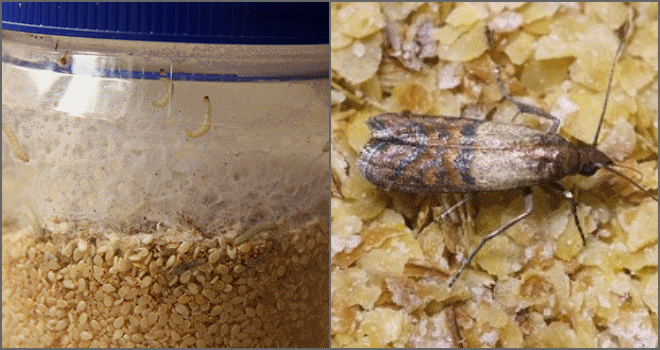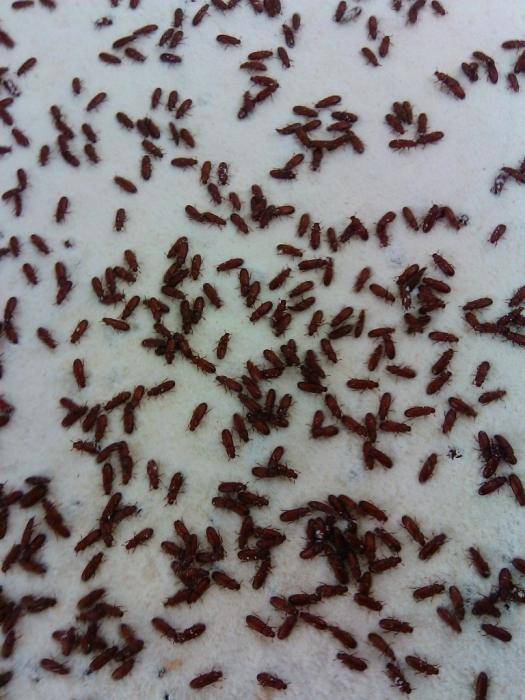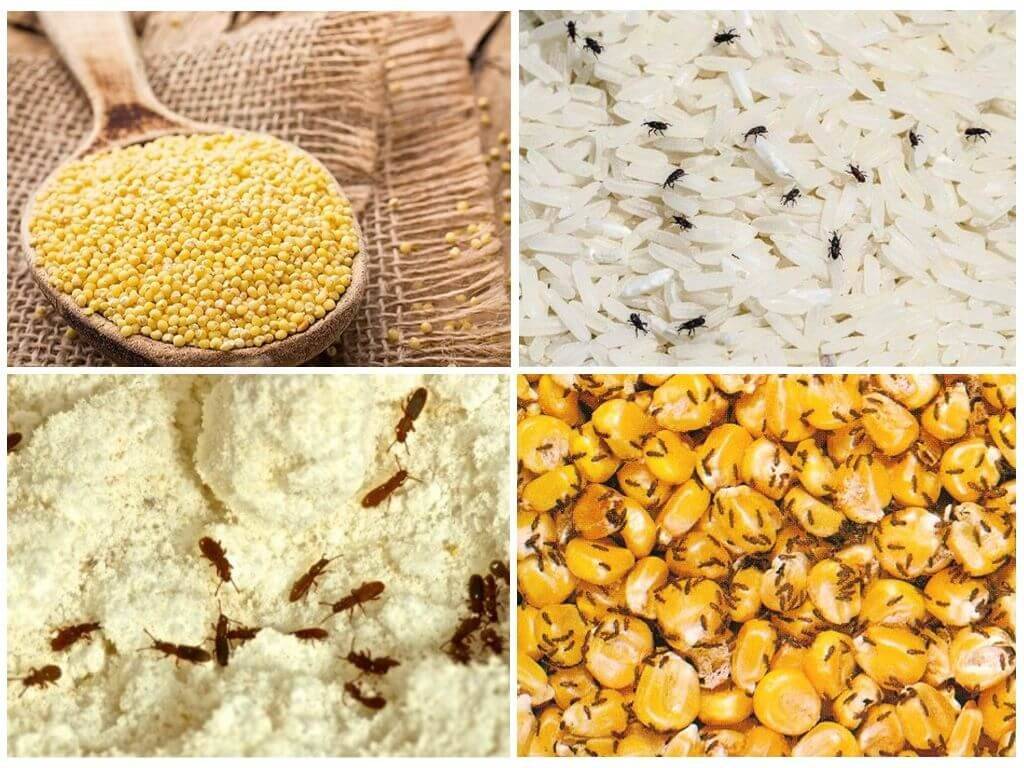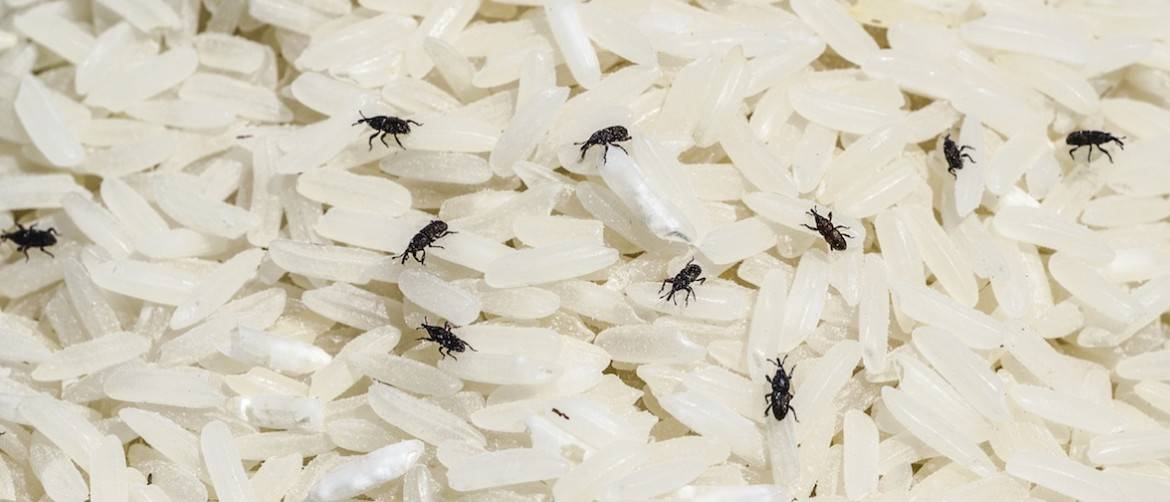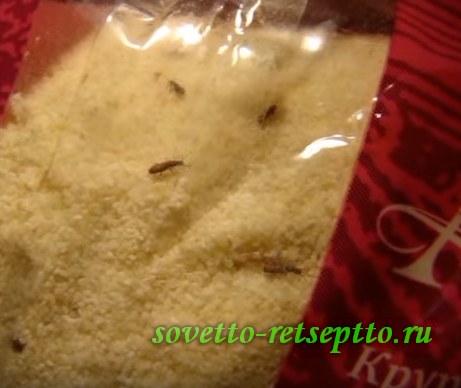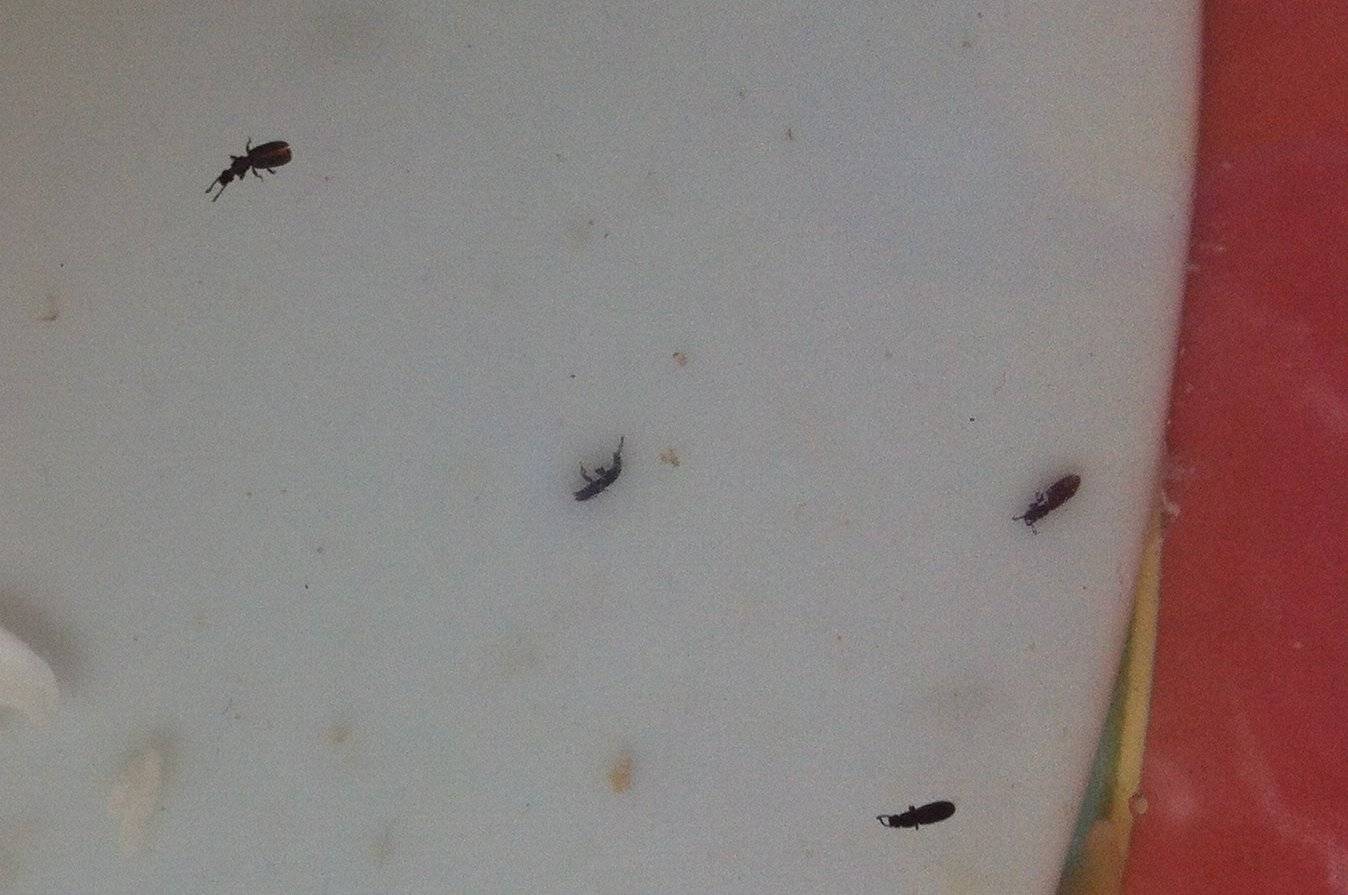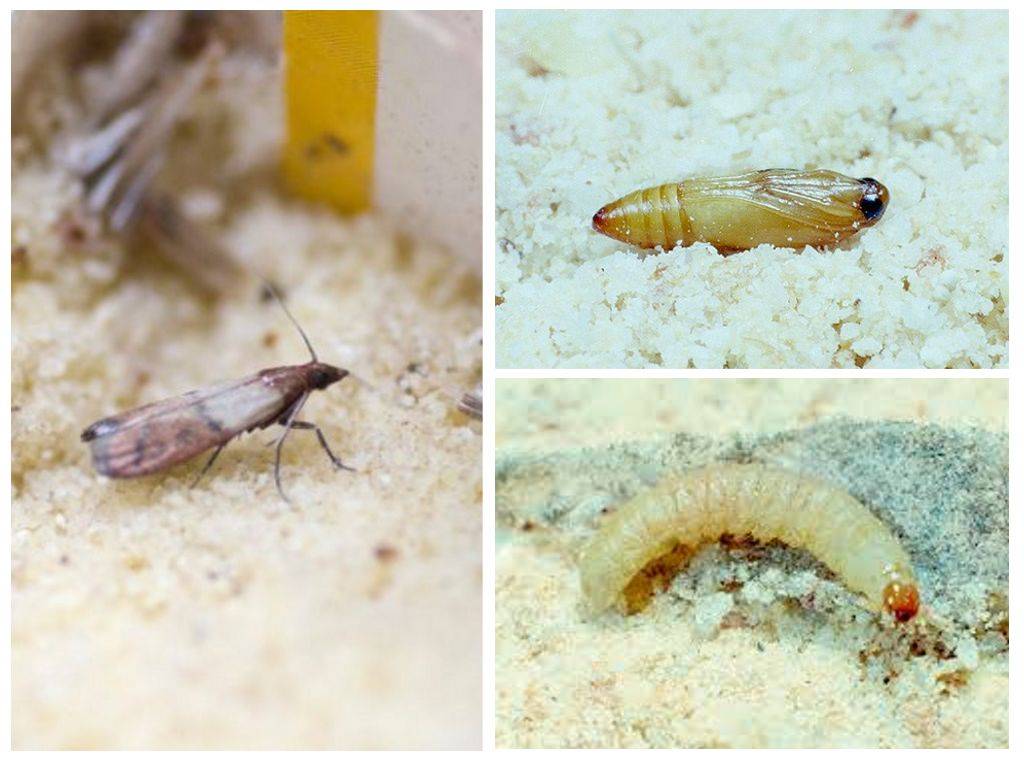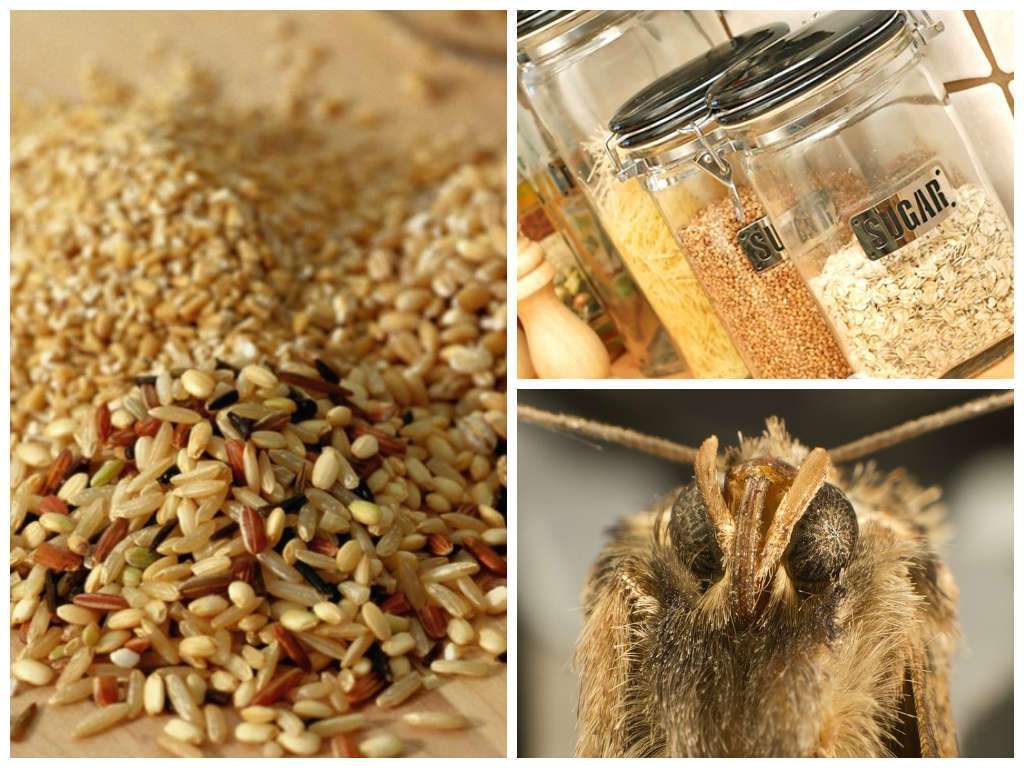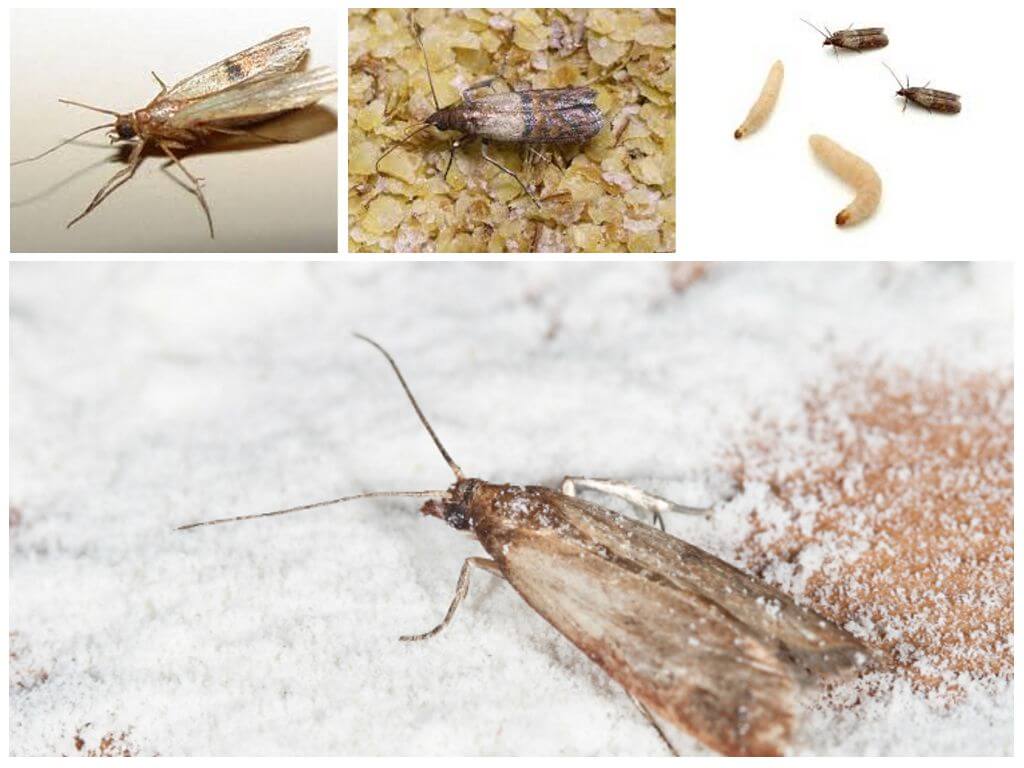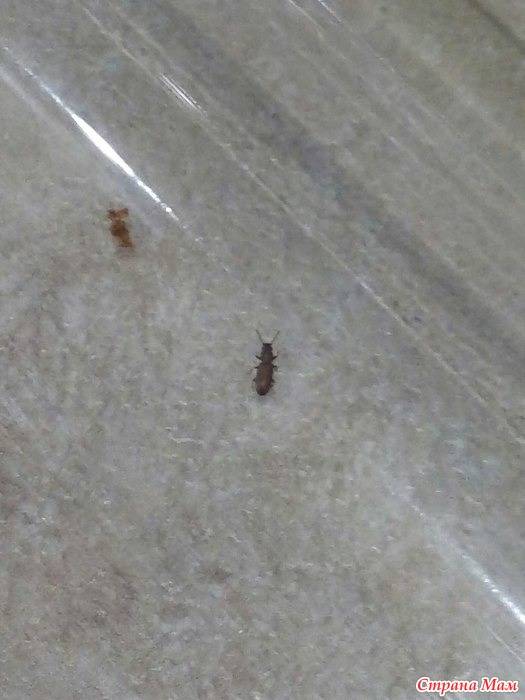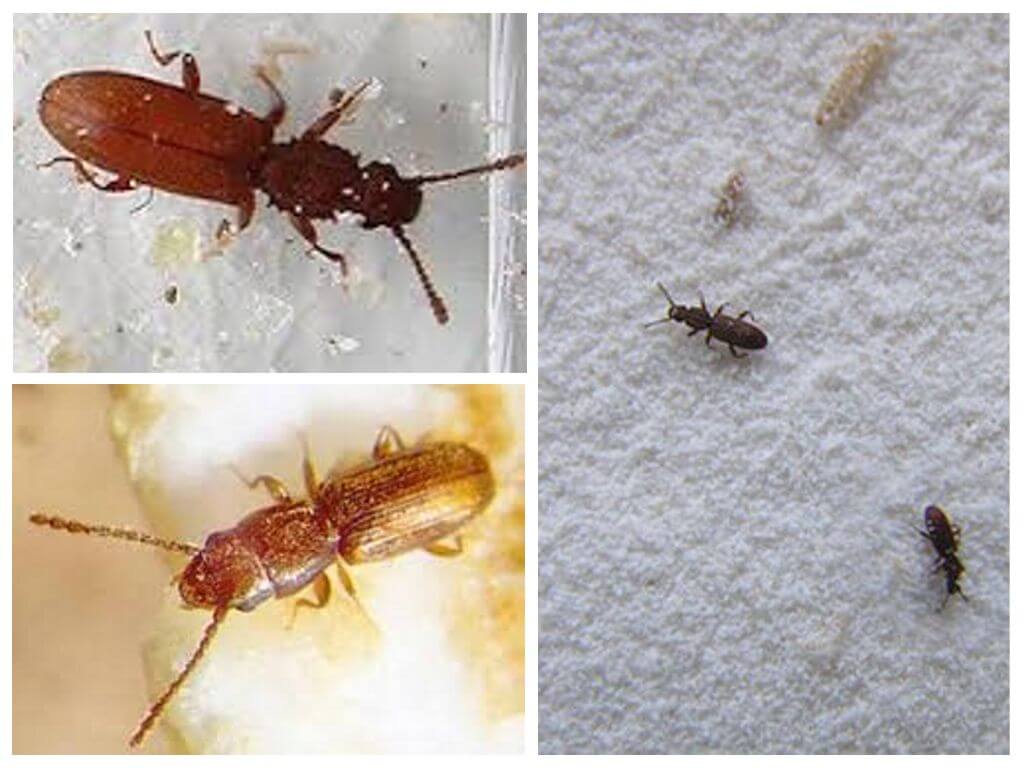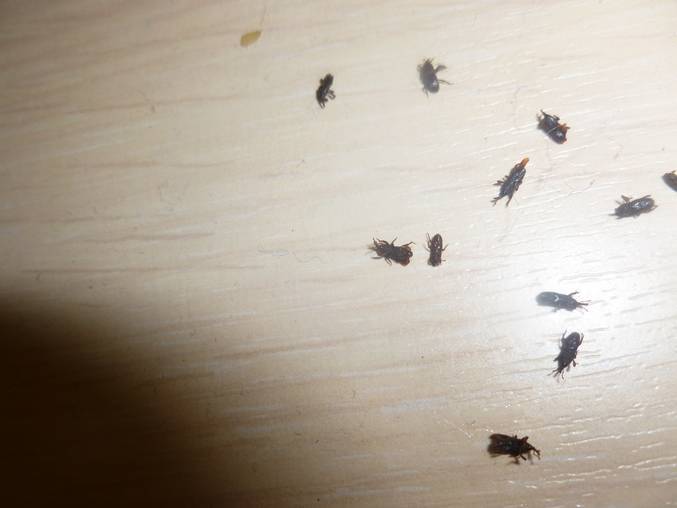What insects can start in cereals and flour
What if there are bugs in the cereal or flour? To know how to get rid of bugs in cereals and flour, you need to know exactly who you need to fight with.
Most often, a mucoid bug and a food moth start up in cereals and flour.
The Surinamese mucoed is an insect of the Coleoptera order, a brown pest. It lives in granaries, mills, shops, houses and apartments.
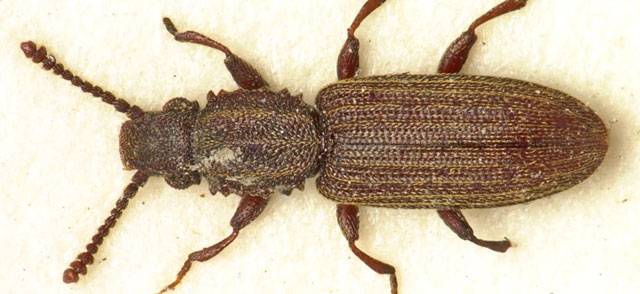
In its development, the muco-eater goes through several stages: an egg, a larva, a pupa, an adult. The larva has a very small size - no more than 0.9 mm, so it is very difficult to detect it. The mucoed lives from 0.5 to 3 years, while laying up to 600 eggs.
Under favorable conditions (air temperature 25-27 degrees and humidity about 65%), the insect reproduces 2-3 times faster than at a lower temperature and humidity.
The food Indian moth is a small butterfly, up to 1 cm long. Lives only 2-3 weeks, but during this time it manages to lay up to 400 eggs, which then become caterpillars. The latter spoil the food, eating everything that is nearby.

After a few weeks, the grown larvae become pupae, and these, in turn, become adult butterflies, ready to produce new offspring.
Both flour eaters and moths are very tenacious, even in frost they do not die immediately. This must be taken into account in order to understand how to get rid of bugs in flour and cereals.
The photo below shows another type of bugs that can start in cereals or flour in your kitchen - this is a flour beetle:
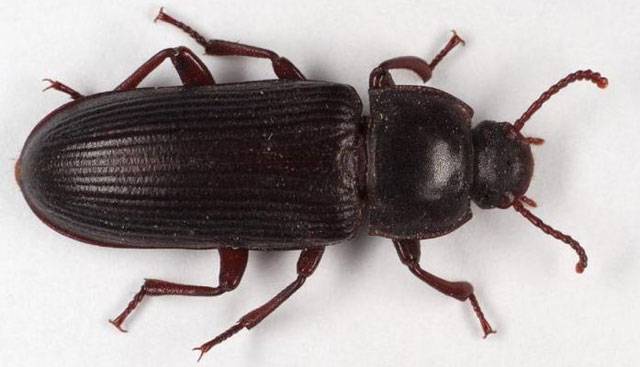
Is it possible to eat cereals, flour, if bugs are in it?
One of the most common questions that people have when they encounter insects in the kitchen: if bugs are in the cereal, is it okay to eat it? Seeing that insects are bred in the cereal or flour, hardly anyone will want to eat them. But if we discard the psychological component, is it possible to sort out the cereal, rinse it and be sure that there are no bugs?
The answer to this question is negative. The fact is that even if you sort out the cereals and remove all the bugs, the larvae can simply not be noticed. They are small and inconspicuous in color.
In addition, the cereal contains the waste products of bugs, caterpillars and larvae: feces, dead larvae, husks that remain during the transformation into a pupa or butterfly.
The situation is somewhat different with flour. It can be sifted into a fine sieve that will not allow larvae or debris left by bugs to pass through. This is one way to get rid of flour bugs.
After such an operation, it is recommended to heat the sifted flour in the oven at 50 degrees.
How to get rid of insects in the kitchen quickly
Do not forget that some pests are prone to rapid reproduction. If you notice bugs in the products, then immediately clean and check the entire room in stages.
All ways to get rid of bugs can be divided into 3 groups:
- mechanical;
- chemical;
- the use of folk recipes.
Mechanical methods
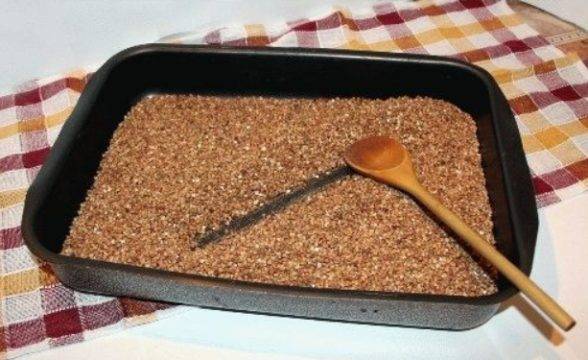
- It is necessary to find all the places of accumulation of kitchen animals. Check all groceries and furniture and do a general cleaning. Unopened packages must be opened and carefully inspected.
- Process all bulk solids. To do this, pour everything one by one onto a baking sheet and heat in the oven. In cold weather, take all the food out onto the balcony for 5 days.
- Do a general cleaning. Clean and wash everything. Treat wooden surfaces with vinegar solution. If you've used a vacuum cleaner, don't forget to clean up your garbage bag. It should be washed and frozen for 5 days. Insects are not afraid of household cleaning products. It is optimal to use boric acid.
- Dishes containing contaminated food should be discarded or washed and frozen.
- In the future, store all bulk products in sealed jars.
- Do not forget to patch up any holes you find.
If there are few insects, then some products should be tried to save. To do this, the cereals must be heated in the oven at a temperature of 100-150 degrees for 10-15 minutes, or, conversely, frozen for 2-3 days.
Chemicals

Chemistry in the kitchen is a last resort. First, try to solve the problem using folk methods. The most harmless chemical is feverfew. They need to be sprinkled at the location of the food. The powder is harmless to humans and pets.
Kitchen cleaning is best done with chlorine-based products. For best results, wipe all surfaces several times.
Specialty shops sell Antizhuk furniture impregnation. She should process all wooden furniture according to the instructions for use. Do not process surfaces that are in direct contact with food.
Folk remedies

To combat kitchen insects, you can use: vinegar, garlic, wormwood, nutmeg. The stronger the smell, the better.
Traps can be prepared for beetles. On the shelves, you need to spread adhesive plaster, sprinkled with garlic and other smelling spices. You need to wipe the storage areas of cereals and other products with vinegar.
Another effective way to get rid of pests is to use boric acid. The effectiveness of this method is that the beetle does not die immediately, but manages to bring poison to the place of accumulation of its relatives. To prepare a trap:
- Lay out sheets of paper or cardboard in the kitchen.
- Mix boric acid with powdered sugar or honey.
- Put the resulting composition on sheets and leave for a couple of days.
How to store cereals so that bugs do not start?
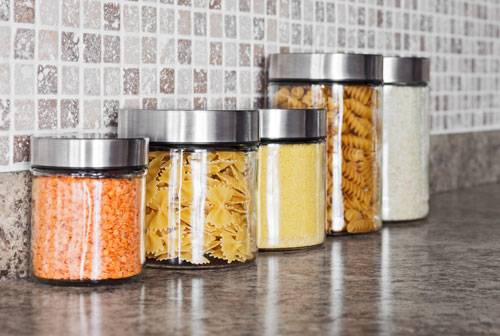
Methods for storing cereals, as well as preventive measures, are quite simple:
- Clean up closets and utility rooms regularly.
- Store free flowing properties only in clean, sealed containers.
- Do not store large quantities of cereals in one place.
- Conduct a weekly contamination control check.
- Put the purchased cereals and flour for a day in the freezer for disinfection.
- Store long-stored foods (legumes, nuts, dried fruits) in the refrigerator.
- The room with stored cereals should be well ventilated and have a low level of humidity.
- For prevention, put a clove of garlic or orange zest in a container with cereals.
- Keep it clean, do not litter.
A bug in the kitchen is not the end of the world. Using these tips, you can easily cope with the problem that has arisen and even warn it.
Where can I find
Insects grow in different products, they love flour and pasta.
Rusks
Bread grinders, which are light brown in color, settle in bakeries. Such bugs fly well, hide under the windows in the apartment and gobble up crackers.
Biscuits
Tiny insects love straws, wind up in dryers, biscuits. Both in a small store and in a supermarket, you can buy gingerbread and pastries, cookies with worms. Such guests appear during long-term storage in the kitchen.
Nuts
Under favorable conditions, food moths begin to multiply. It is not poisonous, but spreads quickly, lays eggs, from which larvae crawl out, adoring walnut kernels.

Dried fruits
From prunes, dried apricots, apricots, compotes rich in vitamins are obtained. But if the harvesting technology is violated, the storage rules are not followed, the dried fruits attack the caterpillars of the microscopic moth.
Food components
The products contain carbohydrates, fats, proteins, which are necessary for the normal functioning of the body. Insects look for food in different food components.
Bread
Not all mini-bakeries follow the technology of baking loaves and other products.And if the norms are violated, the bugs will climb into damp bread from the infected flour.
Beans
In legumes, weevils appear not only due to improper storage, parasites attack plants even in the garden before harvesting. If at least one bug is detected in the beans, they are sent to the freezer or hot oven.
Tea coffee
In the closed cabinets where spices and cereals are stored, grinders can be brought from the store, and the moth loves not only dried fruits. Insects do not mind eating tea, cocoa, coffee beans.
Flour
Bugs that hit the kitchen begin to feed on bulk foods and spices. Wheat, rye, and corn mills produce flour, which is packed in bags and packages and transported to stores or to a warehouse. You can buy such a product with bugs.
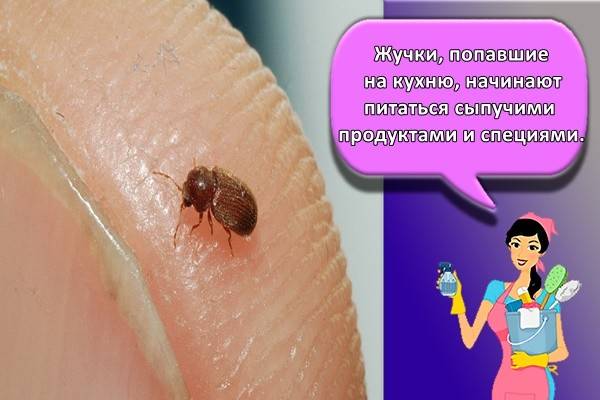
Vegetables
In recent years, a lot of pests have appeared on the fields. To cope with insects, crops have to be sprayed. But if cucumbers, cabbage or tomatoes are stored in improper conditions, then they begin to rot, worms and beetles appear.
Furniture
Grinders live in old sofas, chairs, wooden floors. Insect larvae feed on wood, making moves in it.
Appliances
In the microwave, in an electric meat grinder, in a gas stove and even in the refrigerator, cockroaches settle, which is not easy to get rid of.
Insects grow and reproduce quickly, but you need to be careful with them in the apartment so as not to harm the household
Hard to reach places
Even clean housewives have bugs in the kitchen, which are difficult to remove, because they hide in the cracks, in the ventilation, crawl under the bath. The springtail insect eats up the roots of flowers, climbing deep into a pot of soil.
How to get rid of re-infestation of bugs in the kitchen
To prevent re-infestation by pests, precautions must be taken:
- Store flour, cereals, biscuits, spices, dried fruits, nuts and animal feed in clean, dry, tight-fitting metal, glass or heavy plastic containers. This method of storage will prevent both bugs from getting into the container and spreading around.
- Another proven storage method is to put cereals in the freezer or refrigerator.
- Some housewives recommend placing in a container with food and on the shelves of the cabinet: several cloves of peeled garlic without cutting off the top; bay leaves, nutmeg or carnation inflorescences; a couple of pads or slabs of mint gum; a steel nail or wire, after wiping it with a dry cloth, as when washing, moisture can corrode the metal and spoil the food.
- Buy food products in such quantity that they can be consumed within 2-3 months.
- First of all, use cereals from already opened or damaged packages.
- When buying cereals, flour or flour products prepackaged at the factory, you need to check the shelf life, the integrity of the package and inspect for the presence of insects in the pack.
- It should be remembered that soft packaging does not protect against pests.
- Food storage areas should be kept clean and dry because accumulated food debris and crumbs are an excellent breeding ground for bugs and gnats.
- If, after the measures taken, the insects reappear, then it is worth examining the neighboring rooms, identifying breeding sites and repeating the preventive actions. If ineffective, it is worth contacting the house parasite control service.
Knowing the types, signs and causes of the appearance, following the tips and recommendations for preventing infection, you can get rid of these nasty little pests forever.
How to store cereals correctly so that bugs do not start?
A common problem with food bugs is improper storage and expiration dates.
What to do to protect yourself from kitchen pests at home.
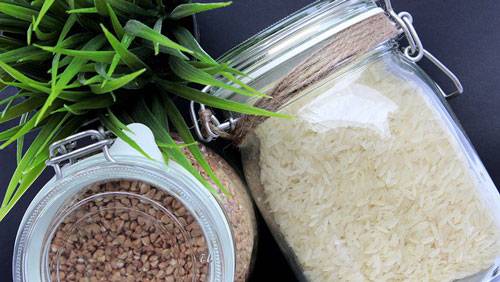
For this, there are useful recommendations on how to properly store cereals so that bugs do not start:
- Perform general cleaning of closets as often as possible.
- Inspect the contents of bulk products, their appearance.
- It is better to store cereals in plastic, iron containers with tightly closed lids.
- Ventilate cabinets where bulk products are stored, open lids in containers.
- The storage area should be dark and cool.
- Along with the products should be spices, pepper, bay leaf, garlic. With their smell, they scare away insects.
- Cloth bags, can be washed with laundry soap. After they must be thoroughly rinsed in clean water. And also treat containers with soap and saline solution.
- If you buy cereals in packages, you need to touch them with your fingers for lumps.
Important to remember! If the products are past their expiration date, you need to dispose of them. They can be a source of infection of other loose cereals with pests .. All housewives should not be allowed high humidity in the room, it is the optimal condition for the propagation and breeding of offspring for insects
All housewives should not be allowed high humidity in the room, it is the optimal condition for the propagation and breeding of offspring for insects.
Useful video
What are these beetles?
Often, small beetles, red flour eaters and grain grinders settle in dry cereals.
Small flour beetles are small, only 3-3.5 mm in size, reddish-brown beetles with short antennae, rounded sides and small wings (however, they cannot fly).
These insects enter the kitchen from the bags with starch or flour brought in, from where they crawl throughout the territory, crawling into cracks, latches, loosely covered containers with dry products. Especially these creatures "respect" flour, rice, buckwheat, semolina, "Artek" groats, millet and dried fruits.
Under favorable conditions, flour beetles reproduce well, bringing up to four generations a year.
Food damaged by the beetle becomes lumpy and, of course, unsuitable for food. Their use is fraught with the appearance of allergic reactions, indigestion or even poisoning.
Red flour eaters, as a rule, live in industrial enterprises - mills, bakeries, feed mills. These are small (1.5-2.5 mm long) coleoptera, rusty-yellow, covered with small silky hairs with long, widely spaced antennae.
The taste preferences of these bugs are rather limited - flour eaters do not damage products with a moisture content of less than 15-17%, they are mainly content with rotting flour or cereals (most often corn) and dry animal feed. Gathering in groups in food, flour eaters increase their moisture content, contaminate with excrement and shells from larvae.
A characteristic sign of the presence of a flour eater is the gnawed flour sieves.
Bread grinders are the most tenacious, prolific, voracious and unpretentious pests. In order to remove them, you will have to make a lot of effort. These are small beetles (1.8-3.7 mm long) of a cylindrical shape from light brown to reddish brown, covered with short silky hairs.
Often, living or dead insects can be seen on the windowsills in the dwelling where the grinders are wound up. They love to feast on dry products of animal and plant origin: various cereals, grains, tea, coffee, flour products, crackers, animal feed, cookies, dried fruits, nuts, dry medicinal plants (even poisonous!) And tobacco.
Traces of the stay of the grinders can also be found in the bindings of books, herbariums, where they leave many passages, depositing the products of their vital activity in them.
The special insidiousness of grain grinders lies in the fact that with a slight infection, their stay in the food substrate occurs secretly - they do not appear outside. But with a high population density, pests can be found on windows, walls and on the floor in the room.
The use of products in which bread grinders are wound up, especially without heat treatment, is unhealthy!
Effective control method
Pathogenic microorganisms settle in cereals, dried fruits, flour damaged by bugs, but not everyone knows whether it is possible to avoid the appearance of insects in food and how to cope with them.
Stock inspection
If there are cereals, spices, tea in the kitchen or in the pantry, or beans, beans, dried apples, plums or pears are stored, the first thing to do is to carefully examine the bulk products. The presence of insects is indicated by the appearance of husks.
Damage assessment
Having found traces of beetles, you need to check how damaged cereals or dried fruits are. The flour can be sieved to get rid of the larvae, if there are few of them. Products heavily gnawed by insects are best destroyed.
Safe processing methods
To remove bugs and larvae, you must first try a method that does not harm humans.
Freezing
Most insects that start in bulk products die at low temperatures. Having identified traces of pests in a bag with cereals, it is left in the freezer for several days.
Roasting in the oven and sifting through a sieve
If the number of beetles and larvae in semolina, flour, millet is small, you should try to save the food. Insects do not tolerate not only low, but also high temperatures. Groats and ground grain are passed through a fine sieve, and then sent to the oven, heating it to 50 ° C.
Disposal
Discovered products that cannot be fried or frozen due to severe insect damage must be immediately taken out with the container to the garbage pit, the compounds used to process the cabinets are drained into the toilet.
Disinfection
In order to finally remove bugs from the kitchen or pantry, all shelves are freed from food, crumbs are swept out and disinfected with a solution prepared from a liter of water and 20 ml of vinegar. The slots in which the insects lay their eggs are poured with boiling water or removed with a vacuum cleaner.
Making bait from borax
You can attract bugs, so that you can deal with them later, with the help of balls, which are laid out in cabinets that have been washed and disinfected in advance. For their preparation, only 3 components are needed:
- milled millet;
- powdered sugar;
- borax.
All ingredients are mixed in equal parts. In addition to balls, pieces of paper with a grated mixture of baker's dry yeast, sugar and borax are laid out on the shelves. Very quickly, bugs will appear near them.
How to deal with odor
Products and herbs with a rich aroma are effective in the fight against food moths, red flour eater and other kitchen insects.
Pyrethrum twigs
The powder of the plant, found in the Transcaucasus and the Balkans, has been used by the people for a very long time to destroy bedbugs and harmful insects. The drug is made from pyrethrum. Perennial twigs have a pungent smell that food bugs do not like.
Bay leaf
The spice, which is always present in the kitchen, gives a bright aroma to any dish, drives away insects that adore flour, lay eggs in dried fruits. Bay leaves are scattered in the corners of the disinfected shelf, the bugs do not like the smell of seasoning.
Dried wormwood
Bitter herb with healing properties grows like a weed near houses and vegetable gardens. It is harvested and dried to remove worms, improve appetite. Insects are not able to withstand the smell of wormwood, and bugs will definitely not crawl into the place where the leaves lie.
Carnation buds
Cotton pads lubricated with essential oils are placed in a cabinet, disinfected after identifying food moths:
- geraniums;
- fir;
- rosemary.
The aroma emanating from the buds of the carnation scares off the bugs. Insects do not tolerate the smell of basil.
Peeled garlic cloves
Bugs rarely start in buckwheat, millet, rice, if a bay leaf or cloves separated from the head of garlic are placed in a container or jar where they are stored.
Lavender
The plant, which has a unique aroma and delicate lilac flowers, is used as a seasoning, brewed as tea, and added to an alcoholic tincture. The smell is very pleasant to people, insects do not tolerate it. You can put a bouquet of lavender flowers and leaves in the closet or a tampon smeared with essential oil. The scent will drive away bugs.
To destroy eggs, larvae, and adult insects, they disinfect shelves, cabinets, and glass or plastic containers if cereals, flour, beans or dried fruits are stored in them. In addition to wiping the surfaces with vinegar, you need to process the container and the room with boiling water, pour over it with steam.
Where pests are most often found
If the kitchen is already infected and there are these insects in flour or cereals on it, you need to find foci of its infection. You will need to view each of the products.

Loose products
It is necessary to take into account the following subtleties:
It is important that you will need to research any product, without exception, from those stored in the kitchen. Each type of such bugs has certain gastronomic tastes.
But in the case when his favorite food is absent in sufficient volume, the bug may emigrate from other cereals into cereals, as well as into sugar, sweets, and nuts. For this reason, you should not skip a single product, so as not to waste a lot of time in vain.
These parasites are strongly attached to their places of residence, so they do not go far from them. If you see them on the shelf, you must first of all inspect the products stored nearby.
Even if the package is sealed, you will need to review it. These insects easily gnaw through materials such as cardboard, cellophane and foil. For this reason, without opening the cereal, you should not at all think that it does not contain parasites.
The best option is to sprinkle the cereal on a plate with a close look. These bugs live and hidden - for example, a grinder can gnaw holes in the grains and live in them, crawling out to the surface just to change the grain. Therefore, a superficial examination is ineffective.
Types of bugs
Unfortunately, cereal parasites can be of several types. They practically do not differ in the degree of harmfulness, but each of them prefers special conditions for life. Views:
- Flour-eater beetle. It is also called the Surinamese muco-eater. Has a red or red color. It prefers to live in moist or rotten cereals, it is also often found inside flour packages. In a group, together with other individuals, they contaminate food, making it more moist. They often come home in rice, semolina or pasta. They can eat bread crumbs, nuts, cookies. Such flour and rice lovers are considered the most common.
- Flour beetle. Outwardly, it resembles another type of beetles that are not dangerous for food - shashel. It has a brown or reddish color, likes to settle in food, bread bins, and also secluded parts of the kitchen, while often spreading from the kitchen cabinet. It grows up to half a centimeter long. It prefers to live in rice grains, wheat and rye flour, semolina, as well as wheat.
- Grinder. Representatives have an oval head, grow up to 3 mm, they are dark yellow or brown. They can enter home by gnawing their way through floors, walls or window frames. They live in pasta, cereals, nuts, cookies or dried fruits.
- Food moth. This insect does not belong to beetles, but it also often appears inside cereal packages. Most often it settles in buckwheat, but it is possible that it appears in other cereals.
- Barn weevil. Adults are black and up to 6 mm long. They cannot fly, but they multiply extremely quickly. They are distinguished by a long proboscis nose. They settle with any cereal.The females lay their eggs inside the kernels, where the insects feed and grow. Therefore, people see them only as adult beetles.
- Caryopsis. The midges of this bug are dangerous only for beans. They prefer high humidity and average air temperature. Females can lay large numbers of eggs in a short time.
If transparent bugs are encountered, then action should also be taken immediately. As a rule, developing individuals, which were just born and did not have time to grow, do not have color. It will be a little easier to deal with them.
Insect species in bulk products
In bulk products, several varieties of harmful insects live:
- flour beetle. The length of the insect is about 4 mm, the color of the body is orange-red. Favorite habitats: kitchen cabinets, bread bins, paper bags with cereals. The insect eats rye and wheat flour, semolina, rice, millet;
- mucoeder Surinamese. Loose foods are an ideal environment for an exotic pest. Tiny (up to 2 mm) bugs actively reproduce in granaries: it is almost impossible to identify the pest without a magnifying device. If the larvae or adults fall into bags with cereals and flour, then from the infected products the pests penetrate into loosely closed containers with dried fruits, cookies, nuts, breadcrumbs, cereals;
- food moth. The pest is larger than the Surinamese flour eater and flour beetle. The lepidoptera grows up to 5–7 mm, the color of the body and wings is light gray with a slight brownish or darker shade. The moth settles in millet, semolina, rice, flour, dried fruits, peas, and other types of bulk products. The pest is actively multiplying, causing great damage to products;
- grinder. A bug up to 3 mm long harms cereals, pasta, sweet liver, dried fruits. The bread grinder actively eats cereals, pasta, sweets, the house type of beetles feeds on wood. If there are grinders in the cabinets, you need to disinfect as soon as possible so that the pests do not equip nests in other furniture.
What are bugs?
There are various pests. On the territory of private housing, flour beetle is common; bread grinders and red flour eaters usually live in production. If there is damage to dried flour products in the kitchen: crackers, biscuits, dryers, it can be argued that bread grinders have wound up in them.
Bread grinder
Their external features: small size (up to 3 mm), light brown body color, the presence of wings.
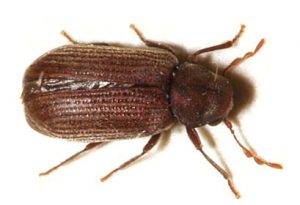
Bread grinders are the most tenacious, prolific, voracious and unpretentious pests.
Such beetles strive for light, for this reason they are often found near windows on window sills. Favorite food besides dried flour products: tea, coffee, dried medicinal plants, animal feed. Such insects are carried along with the contaminated product, from where they spread through supplies in the kitchen.
Ginger flour eater
If we consider the red flour eater, then it is usually found in production: flour mills, cereal factories, bakeries. Such bugs in flour and cereals can start up, on which traces of rotting are noticeable. To avoid food contamination, store them at a low humidity (no more than 15%). If these recommendations are violated, insects will immediately infect the cereals. External signs of beetles: small size (up to 2.5 mm), reddish color of the body.
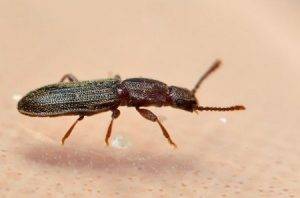
This pest cannot damage dry grain, the moisture content of which is below 15%.
Flour beetle
On the territory of private housing, flour beetle is common. It is a red-brown insect, ranging in size from 3 to 4 mm. It is usually brought along with the contaminated product, from where it is settled in the kitchen on clean cereals. Beetles prefer any flour: rice, wheat, rye. In addition, they settle in semolina, oatmeal. If there is no other food or under the condition of severe infection, rice, buckwheat, and dried fruits may also suffer in the kitchen.

These insects are especially "respected": flour, rice, buckwheat, semolina, Artek groats, millet and dried fruits.
It doesn't hurt to know where they live. The most common type is the flour beetle lays eggs in cereals, cabinet crevices and other furniture in the kitchen.
Are contaminated foods eaten?
If there are too many insects, it is a pity to throw away flour, rice, buckwheat and other cereals. This raises the question, is it possible to eat them with bugs? The answer is no, since there is a danger of poisoning. In addition, allergic reactions occur in people who eat such food.
Infected flour and cereals completely lose their beneficial properties, since the beetles draw out all the nutrients from the grain. Accordingly, the nutritional value of such products is extremely low.
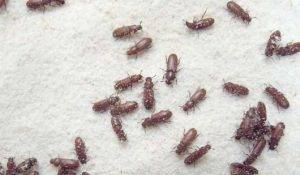
If bugs are wound up in the cereal in large quantities, it will not work to save it, it is better not to risk it and throw the product away.
What is this pest
The ginger flour eater is found in mills, bakeries, cereals and processing plants. Dry grain with a moisture content of 15% does not damage the bug. It feeds on rotten spoiled grains. For this reason, it is difficult for him to find suitable food in the apartment.
Most likely, he himself will die, not finding suitable living conditions. The ginger flour eater can be encountered by farmers and villagers who raise livestock. The insect grows up in stocks of grain, mixed feed and low quality cereals. Bread grinders are light brown bugs. Small - up to 3 mm.
Usually found on windowsills. At home, they can eat tea, coffee, medicinal dried herbs. Book covers are to your taste. They can also start in animal feed - compound feed, crushed grain mixture.
Very often in home stocks of cereals, flour, small dark bugs start up. In science, they are called Oryzaephilus surinamensis Mucoed Surinamese, in the people - just a flour eater, a flour beetle. Body length does not exceed 3.5 mm. Dark, almost black body color with a red tint. A dense carapace protects the back and head. The body is divided into 2 parts.
Mistresses on a note
In order to avoid the forced fight against parasites, it is advisable to insure against their occurrence in advance. In order not to puzzle over how to get them out, you need to adhere to cleanliness, providing periodic ventilation of the cabinets.
If the furniture products are highly airtight, then the air does not circulate in them, you should constantly ventilate the furniture by opening the cabinets for a short time. Other preventive measures:
- Avoid storing large quantities of groceries. This will not save you from bugs in flour and cereals, but it will significantly reduce the damage if the parasites do settle.
- Use sealed containers, glass and plastic, and tight lids.
- Dust should be used in the presence of large stocks. It is available in markets and shops. This substance is scattered on the floor and under the bags. Dust scares away insects, but it is completely safe for people.
- Different products need to be kept separate, without keeping everything on a single shelf. For example, it is better to hide dried fruits away from cereals.
- Garlic is an effective prophylactic agent. In each jar of cereals, you should put one slice of it. You can put a dry bay leaf between the jars; parasites do not like its smell.
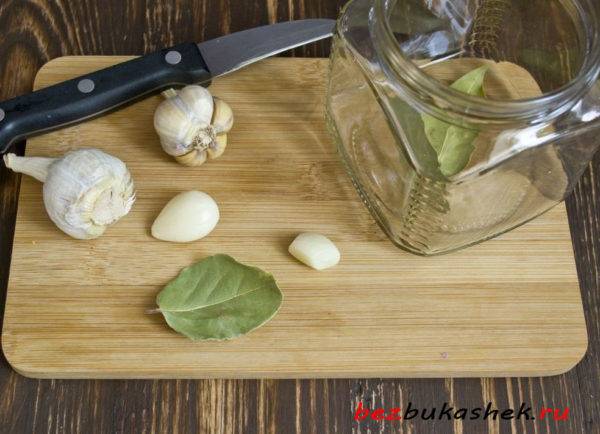
Garlic with lavrushka
In the case of storing cereals in textile bags, these products can be "salted". For this purpose, a salt solution is prepared (2 tablespoons per 1 liter), then the bags are soaked in it. After 30 minutes, these bags should be removed and dried. After such treatment, the pests do not approach the bags.
What bugs start in products
There are only a few types of small insects in cereals and flour. They need to be identified in order to understand how dangerous bugs are in flour, pasta, dried fruits and what potential harm they can cause to humans.
A bread grinder is a pale brown beetle no more than 3 mm in size.Penetrates into the apartment along with his favorite food - breadcrumbs, biscuits, dryers - any hard baked goods, in which passages and excrement will become noticeable over time. In the house, grinders do not disdain tea, dry herbs, try muesli, chocolates. They notice them on light surfaces, when there are already a lot of bugs in the reserves, and they fly into the light in search of a new home.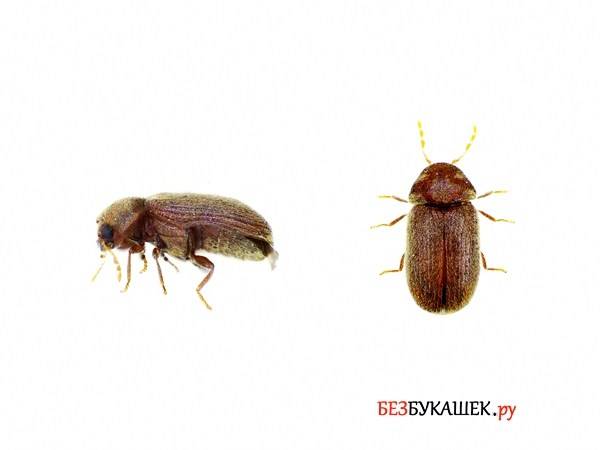
Small flour beetle is a small insect (no more than 3 mm) of red-brown shades. Khrushchaks, or flour bugs, arrive in the kitchen in bags of flour and starch, and from there disperse into loosely closed jars and boxes. Their culinary preferences are any kind of flour, rolled oats, semolina, wheat. Flour beetles breed in the crevices of the cupboards, so the furniture also needs to be sanitized.
The ginger flour-eater is a bug with a light brown or reddish body no more than 2.5 millimeters long. Lives and reproduces in flour and cereal plants, elevators and grain warehouses, if there is frozen grain or rotten flour. Once at your home, he will most likely die, because he does not like dry foods. He comes to residential buildings with flour, cereals or in packs of cheap grain feed for ornamental rodents and rabbits.
A close relative of this species - the Surinamese muco-eater, perhaps, differs only in color (dark brown).

